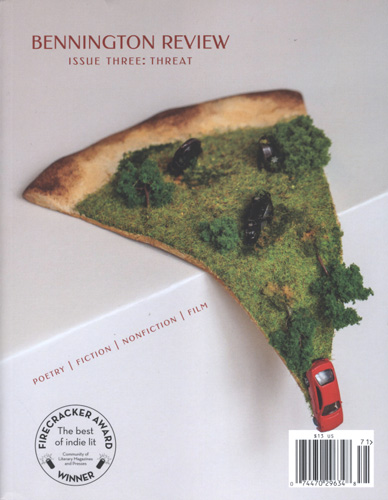Bennington Review – Summer 2017
“Cultural Landscape,” the cover image by Jakub Geltner that kicks off Issue Three: Threat, is a special kind of eye-catcher. A slice of pizza hangs precariously over a table’s edge, its cheese replaced by grass, its toppings swapped for uprooted trees and tumbling cars caught up in some unfamiliar landslide, slipping toward an undefined kind of doom.
“Cultural Landscape,” the cover image by Jakub Geltner that kicks off Issue Three: Threat, is a special kind of eye-catcher. A slice of pizza hangs precariously over a table’s edge, its cheese replaced by grass, its toppings swapped for uprooted trees and tumbling cars caught up in some unfamiliar landslide, slipping toward an undefined kind of doom.
The mood set, Editor Michael Dumanis explains that the issue’s theme threat was chosen on November 10, 2016, two days after “a certain historical event.” He writes that, as a result of this sudden sense of dislocation and anxiety, the editors “gravitated toward poems and stories and essays where paradigms where [sic] similarly disrupted, where characters suddenly found themselves destabilized by external forces, where institutions and individuals in which we’d placed our trust failed to hold up their end of the bargain.”
Just such a paradigm is evidenced in Su-Yee Lin’s “A Flock, a Siege, a Murmuration,” a gorgeously-crafted short story, melancholy yet hopeful, overflowing with realistic detail. In the piece, an American expat living in Shanghai volunteers to cull birds in the midst of the deadly avian flu of 2013. Hers is a story of alienation, fear, isolation, shame, and secret pride. Lin’s protagonist is obsessed with the birds, with their characteristics, and with her own capacity to detach and examine. Between the sessions in which she places chickens, ducks, pigeons, and geese into sacks, pumping in carbon dioxide until they die, she visits the Xixi wetlands, whose famous swans have been tested and spared. She watches them alone. After the threat recedes and life returns to an approximation of normality, the protagonist lures a sparrow into her palm with sesame-and-scallion bread. “He hopped into my gloved palm,” Lin writes. “I laid my other hand over his head. I felt the rapid beating of his heart but he did nothing but flutter his wings. How easy it is to crush a life. How hard it is to save one.”
In contrast, “The Alternative Weekly” by Elisa Albert suffers from a vulgarity of spirit and language. The story follows two unfaithful protagonists, the editor and the artist, alternating between their perspectives in close third-person perspective. Reflecting on his first wife, the editor thinks, “Well, fuck her. She probably has hypertension by now, a pill organizer. Fat ankles, the worst.” The artist is not any better. “Too much self-awareness and you’re a paralyzed parody, a useless cum rag,” she tells her students. In an interview that follows the piece, Monica Ferrell asks Albert if she ever goes too far. “There is a time and place for sentimentality and small talk. Art and literature is not that place,” she responds. Later, both anticipating and responding to criticism, Albert says, “Fuck ‘em if they can’t take a joke.”
In “At the Last Trump,” Bruce Beasley blends family history, politics, religion, and the game of Spades seamlessly together, touching on George Wallace, Nixon, and the current president of the United States. His poem is about naïveté, growing up, learning the less honorable ways to win. His mother is paying him a quarter per deal to occupy his grandmother’s time. Meanwhile, his grandmother is paying him fifty cents for each memorized Corinthians verse. Beasley weaves an impressive, multi-layered poem. He writes:
The dead shall be raised
incorruptible, I recited for my grandmother, trumping
her ace, as she handed me two quarters,and we shall be changed.
“A Girl of a Certain Age” by Miriam Cohen features two roommates staring into the yawning gap of perpetual singlehood. Both women are fascinated by Law & Order: SVU and use their abundant spare time to craft a murder-musical filled with singing dogs. Their attention shifts, temporarily, when a real-life crime lands, surprisingly, in their midst. Another strong contribution is “Glory Fades and Shines: On Rushmore and Empathy,” Kristi McKim’s wonderful essay on Wes Anderson’s film, in which she “discover[s] the glorious shining and humbling joy in realizing one’s perception of the world to be merely partial.”
Issue Three of Bennington Review is as large as its theme, and it contains many more pieces for readers to explore. Other highlights include poems by Phillip B. Williams, Anjuli Fatima Raza Kolb, the incomparable Nick Flynn, William Brewer, Mary Ruefle, Peter Cooley, Carlie Hoffman, and Erika Meitner. A few minor typos aside, this is an incredibly strong issue put forth by an excellent journal. While the “political, global, localized, or existential” threats identified by the editors are real and concerning, we’d do well to apply Kristi McKim’s words, aimed at Wes Anderson’s films, in a wider sense, to all art, “not as a countermove to or distraction from pain but as a means of making form, of contriving structures, of creating space within which to feel, empathize, heal, and learn.”
[www.benningtonreview.org]





